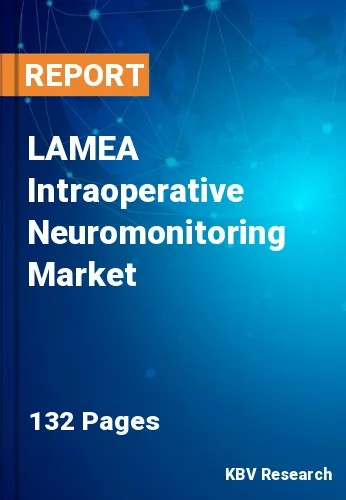The Latin America, Middle East and Africa Intraoperative Neuromonitoring Market would witness market growth of 8.5% CAGR during the forecast period (2023-2030).
During brain tumor resection, IONM assists surgeons in navigating delicate areas of the brain while minimizing damage to adjacent functional regions. Monitoring cortical and subcortical functions helps preserve cognitive and motor abilities. In neurovascular procedures, such as aneurysm repair or arteriovenous malformation (AVM) surgery, IONM monitors cerebral and cranial nerve function. This helps prevent complications associated with neural compromise during these delicate interventions. IONM is applied in maxillofacial surgeries and cranial procedures to monitor nerves responsible for facial sensation, motor function, and vision. This ensures that these critical functions are preserved during complex surgical interventions.
The incorporation of AI in IONM systems enables automated data analysis. AI algorithms can process large volumes of neural data in real time, providing surgeons with instant insights and alerts based on sophisticated pattern recognition. This trend enhances the accuracy and efficiency of IONM. Telemedicine in IONM allows remote monitoring of surgeries, enabling experts to provide guidance and support from a distance. This trend facilitates collaboration among surgeons and specialists, overcoming geographical barriers and expanding access to expert advice.
Orthopedic surgeries, such as spinal fusions and joint replacements, are common in South Africa. The availability of more sophisticated and user-friendly monitoring systems makes it easier for healthcare providers in South Africa to integrate IONM into their surgical practices. Medical professionals in South Africa often rely on evidence-based practices, and research plays a pivotal role in shaping clinical decisions. As the overall volume of surgical procedures increases in South Africa, the need for technologies like IONM that enhance surgical precision and patient safety will likely grow. As medical facilities in South Africa enhance their capabilities for complex surgeries, IONM becomes essential for real-time monitoring of neural structures. Thus, due to these aspects, the market will expand across the LAMEA region in upcoming years.
The Brazil market dominated the LAMEA Intraoperative Neuromonitoring Market by Country in 2022, and would continue to be a dominant market till 2030; thereby, achieving a market value of $146.5 million by 2030. The Argentina market is showcasing a CAGR of 9.6% during (2023 - 2030). Additionally, The UAE market would register a CAGR of 8.2% during (2023 - 2030).
Free Valuable Insights: The Worldwide Intraoperative Neuromonitoring Market is Projected to reach USD 7 Billion by 2030, at a CAGR of 6%
Based on Source Type, the market is segmented into Insourced Monitoring, and Outsourced Monitoring. Based on End User, the market is segmented into Hospitals, and Ambulatory Surgical Centers (ASCs). Based on Products & Services, the market is segmented into Services, Systems, and Accessories. Based on Application, the market is segmented into Spinal Surgery, Neurosurgery, Orthopedic Surgery, ENT Surgery, Vascular Surgery, and Others. Based on Modality, the market is segmented into Electromyography (EMG), Electroencephalography (EEG), Motor Evoked Potentials (MEPs), Somatosensory Evoked Potentials (SSEPs), Visual Evoked Potentials (VEPs), and Brainstem Auditory Evoked Potentials (BAEPs). Based on countries, the market is segmented into Brazil, Argentina, UAE, Saudi Arabia, South Africa, Nigeria, and Rest of LAMEA.
By Source Type
By End User
By Products & Services
By Application
By Modality
By Country
Our team of dedicated experts can provide you with attractive expansion opportunities for your business.

